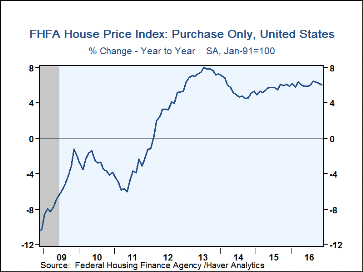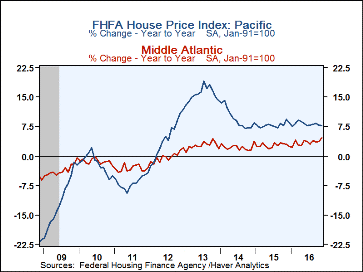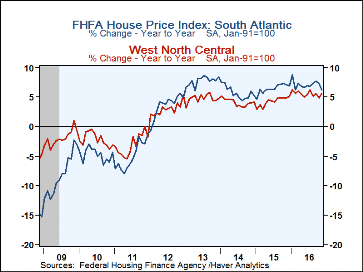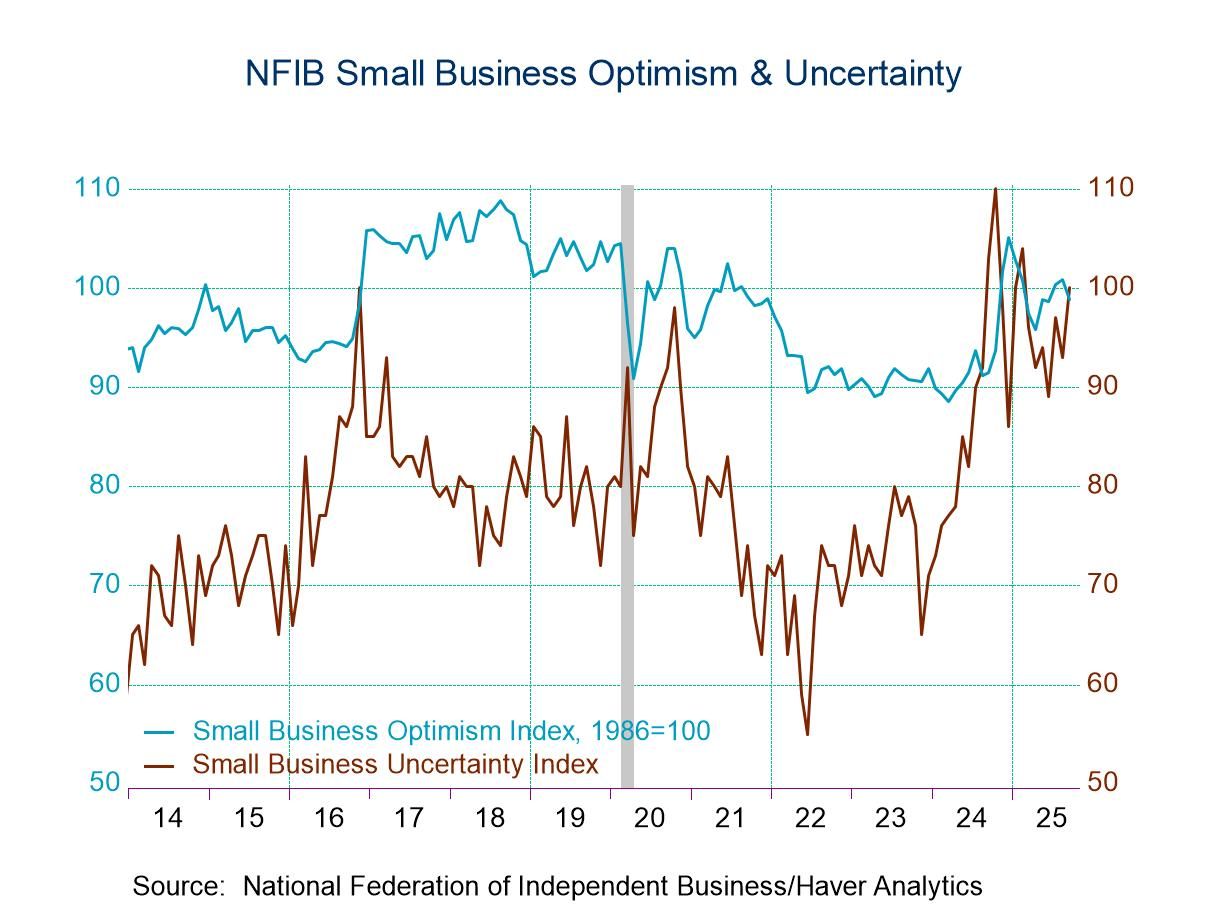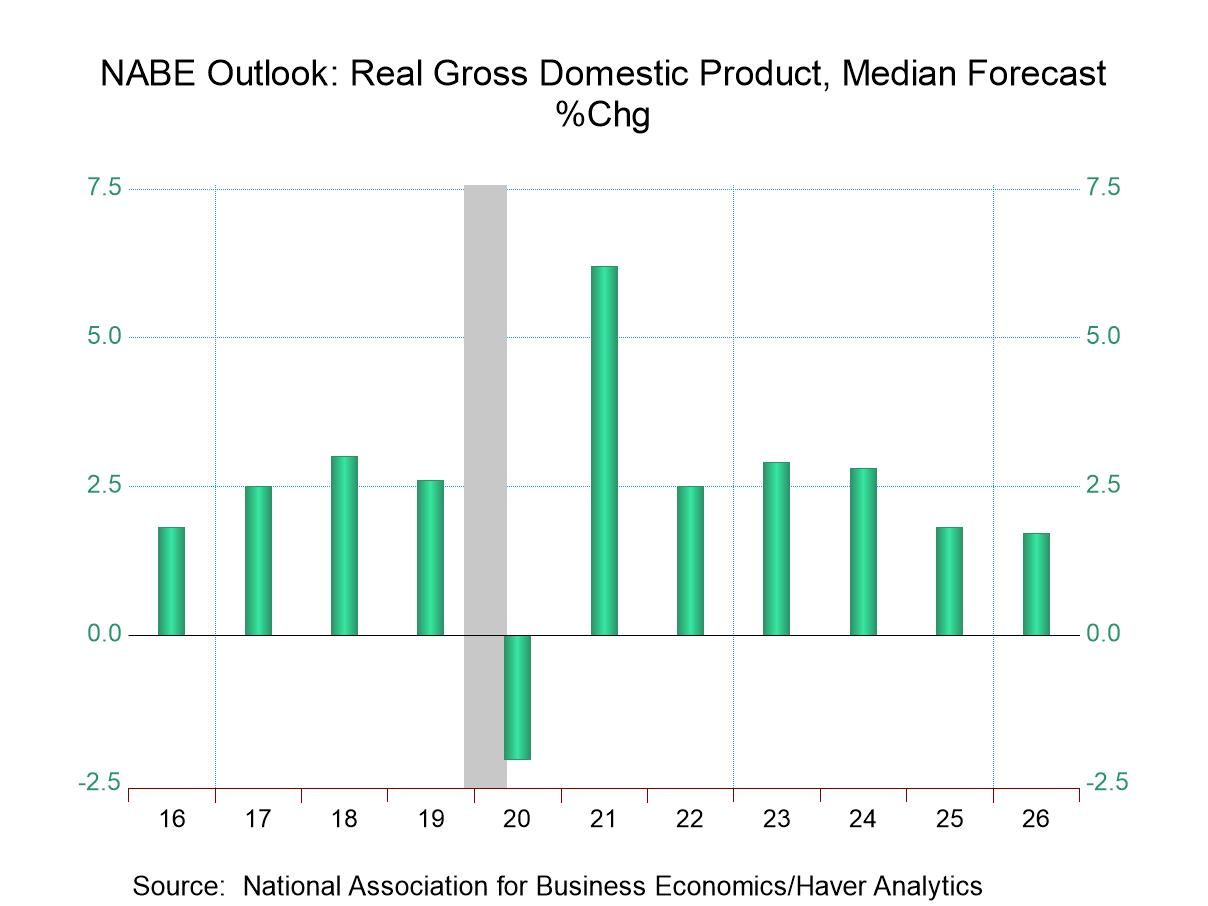 Global| Jan 25 2017
Global| Jan 25 2017U.S. FHFA House Price Index Increase Improves
by:Tom Moeller
|in:Economy in Brief
Summary
The Federal Housing Finance Agency's (FHFA) index of U.S. house prices rose 0.5% during November after a 0.3% gain in October, revised from 0.4%. The y/y change remained fairly steady at 6.1%, but the three-month annualized growth of [...]
The Federal Housing Finance Agency's (FHFA) index of U.S. house prices rose 0.5% during November after a 0.3% gain in October, revised from 0.4%. The y/y change remained fairly steady at 6.1%, but the three-month annualized growth of 6.2% was down from September's firmer 7.9%.
On a monthly basis, prices rose in each area of the country except the South Atlantic and West South Central regions. The monthly gain was strongest in the Pacific states where prices rose 1.5% (7.7% y/y). In the East South Central region, prices also firmed by 1.2% (5.5% y/y).
Elsewhere, much of the country also experienced firm home price growth. In the West North Central area prices rose 0.9% (5.6% y/y), as they did in the Middle Atlantic states (4.7% y/y). In the Mountain states, prices increased 0.8% (7.5% y/y), and the New England region experienced the same gain (5.6% y/y).
Weakness in home prices was registered in the East North Central region where they held steady m/m (5.4% y/y). Declines in prices were experienced in the South Atlantic region where they fell 0.2% (+6.2% y/y). In the West South Central states, prices slipped 0.1% (+5.8% y/y).
The FHFA house price index is a weighted repeat sales index, measuring average price changes in repeat sales of the same property. An associated quarterly index also includes refinancings on the same kinds of properties. The indexes are based on transactions involving conforming, conventional mortgages purchased or securitized by Fannie Mae or Freddie Mac. Only mortgage transactions on single-family properties are included. The FHFA data are available in Haver's USECON database.
| FHFA U.S. House Price Index, Purchase Only (SA %) | Nov | Oct | Sep | Nov Y/Y | 2015 | 2014 | 2013 |
|---|---|---|---|---|---|---|---|
| Total | 0.5 | 0.3 | 0.7 | 6.1 | 5.7 | 5.4 | 7.3 |
| Pacific | 1.5 | 0.0 | 1.4 | 7.7 | 7.9 | 9.5 | 15.8 |
| Mountain | 0.8 | 1.1 | 0.8 | 7.5 | 7.9 | 7.2 | 12.3 |
| South Atlantic | -0.2 | 0.4 | 0.9 | 6.2 | 6.5 | 5.8 | 7.8 |
| West South Central | -0.1 | 0.1 | 1.0 | 5.8 | 6.4 | 5.6 | 6.0 |
| West North Central | 0.9 | -0.1 | 0.6 | 5.6 | 4.4 | 4.1 | 4.8 |
| New England | 0.8 | 1.0 | 0.2 | 5.6 | 3.4 | 3.1 | 3.7 |
| East South Central | 1.2 | -0.6 | 0.1 | 5.5 | 4.8 | 3.5 | 4.0 |
| East North Central | 0.0 | 0.5 | 0.3 | 5.4 | 4.6 | 4.5 | 5.3 |
| Middle Atlantic | 0.9 | 0.2 | 0.2 | 4.7 | 2.8 | 2.2 | 2.7 |
|
|
Tom Moeller
AuthorMore in Author Profile »Prior to joining Haver Analytics in 2000, Mr. Moeller worked as the Economist at Chancellor Capital Management from 1985 to 1999. There, he developed comprehensive economic forecasts and interpreted economic data for equity and fixed income portfolio managers. Also at Chancellor, Mr. Moeller worked as an equity analyst and was responsible for researching and rating companies in the economically sensitive automobile and housing industries for investment in Chancellor’s equity portfolio. Prior to joining Chancellor, Mr. Moeller was an Economist at Citibank from 1979 to 1984. He also analyzed pricing behavior in the metals industry for the Council on Wage and Price Stability in Washington, D.C. In 1999, Mr. Moeller received the award for most accurate forecast from the Forecasters' Club of New York. From 1990 to 1992 he was President of the New York Association for Business Economists. Mr. Moeller earned an M.B.A. in Finance from Fordham University, where he graduated in 1987. He holds a Bachelor of Arts in Economics from George Washington University.


